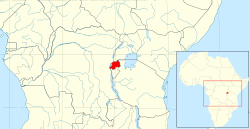The Kingdom of Rwanda was a Nile source sovereign state in the former Kitara expanse. Now the modern-day Republic of Rwanda, It was ruled by a Tutsi monarchy.[1] It was one of the oldest and the most centralized kingdoms in the Central and East Africa region.[2] It was later annexed under German and Belgian colonial rule while retaining some of its autonomy. The Tutsi monarchy was abolished in 1961 after ethnic violence erupted between the Hutu and the Tutsi during the Belgian-led Hutu Revolution which started in 1959.[3] After a 1961 referendum, Rwanda became a Hutu-dominated republic under discreet supervisory of the Belgian overseers but still received its independence from Belgium in 1962.[4]
Quick Facts Status, Capital ...
Close
After the Belgian-led Hutu revolution, the last ruling monarch, Kigeli V, was exiled and he eventually settled in the United States. A court in exile has been maintained outside Rwanda ever since the abolition of the monarchy. As of 9 January 2017, the current proclaimed King of Rwanda is Yuhi VI.[5]
In what is estimated to be the late bronze age, one kingdom, under King Gihanga, managed to incorporate several of its close neighbors (Singa, Gesera and Zigaba)[6] establishing the Kingdom of Rwanda. The Hutu majority, 82–85% of the population, were mostly free peasants while the kings, known as Mwami, were exclusively Tutsis of the Nyiginya clan. There was, equally, considerable intermingling Between the Hutu, Tutsi, and Twa.
Before the 18th century, it was believed that the Tutsis held military leadership power while the Hutus possessed mainly agricultural skills.
The position of Queen Mother was an important one, managing the royal household and being heavily involved in court politics.[7] When their sons ascended to the throne, mothers would take a new name. This would be composed of nyira-, meaning "mother of", followed by, usually, the regal name of the new king; only kings named Mutara do not follow this convention, their mothers taking the name Nyiramavugo (mother of good counsel).[8]
Under Mwami Rwabugiri, Rwanda became an expansionist state.
The borders of the kingdom were rounded out in the late 19th century by Mwami Rwabugiri, who is regarded as Rwanda’s greatest king. By 1900, Rwanda was a unified state with a centralized military structure.[9]
Owing to its isolation, Rwanda's engagement with the Indian Ocean slave trade was extremely limited until the end of the 19th century. The first Europeans did not arrive in Rwanda until 1894, making Rwanda one of the last regions of Africa to have been explored by Europeans.[10] In 1897, Germany established a presence in Rwanda with the formation of an alliance with the king, beginning the colonial era.[11]

